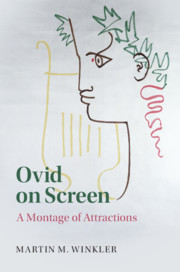Book contents
- Ovid on Screen
- Ovid on Screen
- Copyright page
- Dedication
- Contents
- Illustrations
- Acknowledgments
- D M
- Adages
- Fade-In: Prooemium
- Part I Theory and Practice
- Part II Key Moments in Ovidian Film History
- Part III Into New Bodies
- Chapter 5 Effects and Essences
- Chapter 6 The Beast in Man: Not Ovid’s, but How Ovidian!
- Part IV Love, Seduction, Death
- Part V Eternal Returns
- Sphragis: End Credits
- Bibliography
- Passages of Ovid’s Works
- General Index
- Plate Section (PDF Only)
Chapter 6 - The Beast in Man: Not Ovid’s, but How Ovidian!
from Part III - Into New Bodies
Published online by Cambridge University Press: 27 January 2020
- Ovid on Screen
- Ovid on Screen
- Copyright page
- Dedication
- Contents
- Illustrations
- Acknowledgments
- D M
- Adages
- Fade-In: Prooemium
- Part I Theory and Practice
- Part II Key Moments in Ovidian Film History
- Part III Into New Bodies
- Chapter 5 Effects and Essences
- Chapter 6 The Beast in Man: Not Ovid’s, but How Ovidian!
- Part IV Love, Seduction, Death
- Part V Eternal Returns
- Sphragis: End Credits
- Bibliography
- Passages of Ovid’s Works
- General Index
- Plate Section (PDF Only)
Summary
Chapter 6 continues the subject of screen metamorphosis from a different perspective. It takes the first metamorphosis in Ovid’s epic, that of the evil Lycaon into a wolf, as its cue to discuss different approaches by filmmakers to putting abnormal psychic phenomena on the screen. Transformations of a human into an animal or into a human monster and someone’s possession of another’s mind are staples of horror stories in word and image. This chapter also examines technical aspects of screen metamorphoses from man to beast. Ovid’s Lycaon sets the scene. The name Lycaon derives from the Greek word for wolf. The Wolf Man, a classic series of horror films, can be shown to derive directly from Ovid. Other films are revealing examples of background Ovidianism. The screen metamorphoses of Dr. Jekyll into Mr. Hyde are instructive for the processes by which such transformations were achieved before CGI. The chapter closes with analyses of two films by Ingmar Bergman (Hour of the Wolf, Persona), in which psychological horror replaces the surface thrills of standard shockers.
Keywords
- Type
- Chapter
- Information
- Ovid on ScreenA Montage of Attractions, pp. 221 - 250Publisher: Cambridge University PressPrint publication year: 2020

